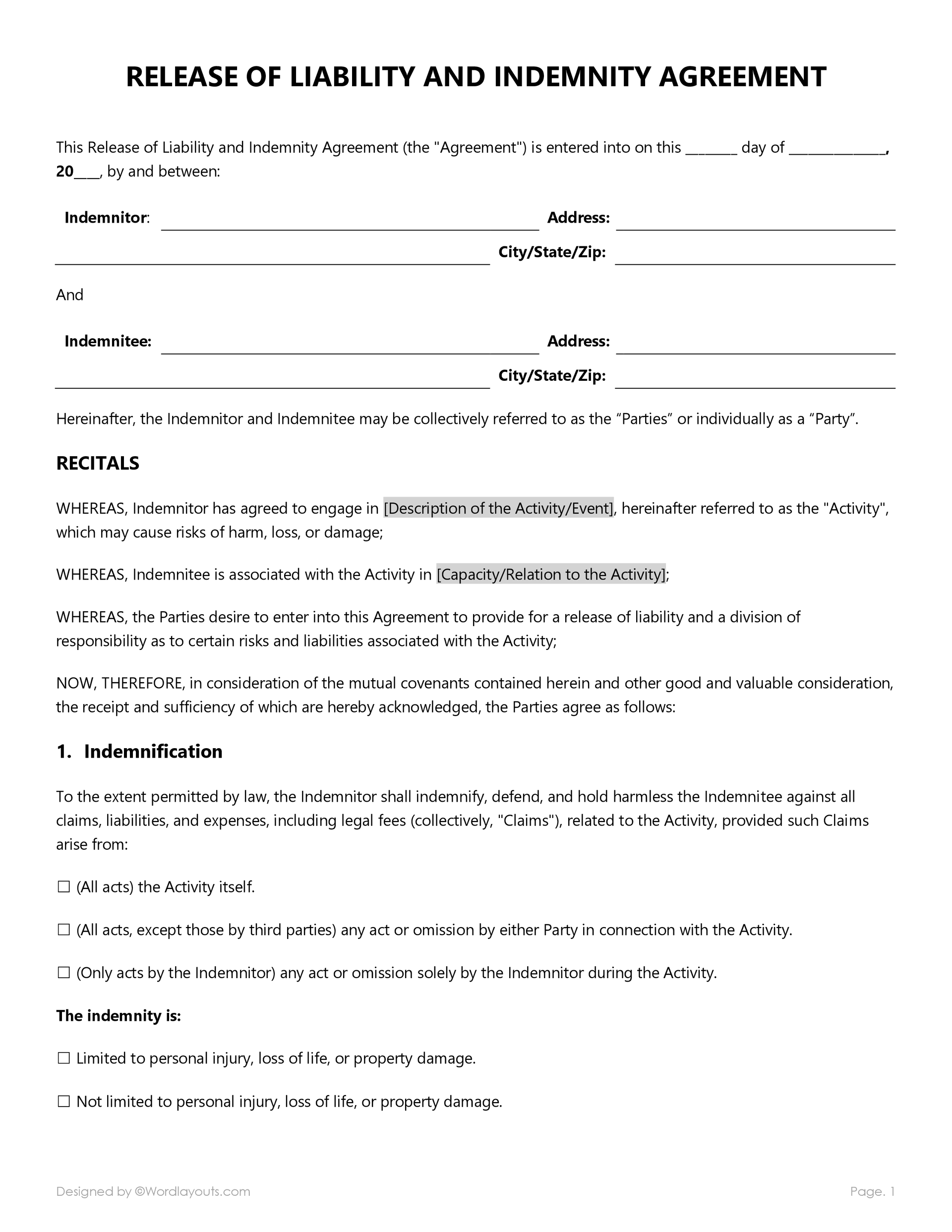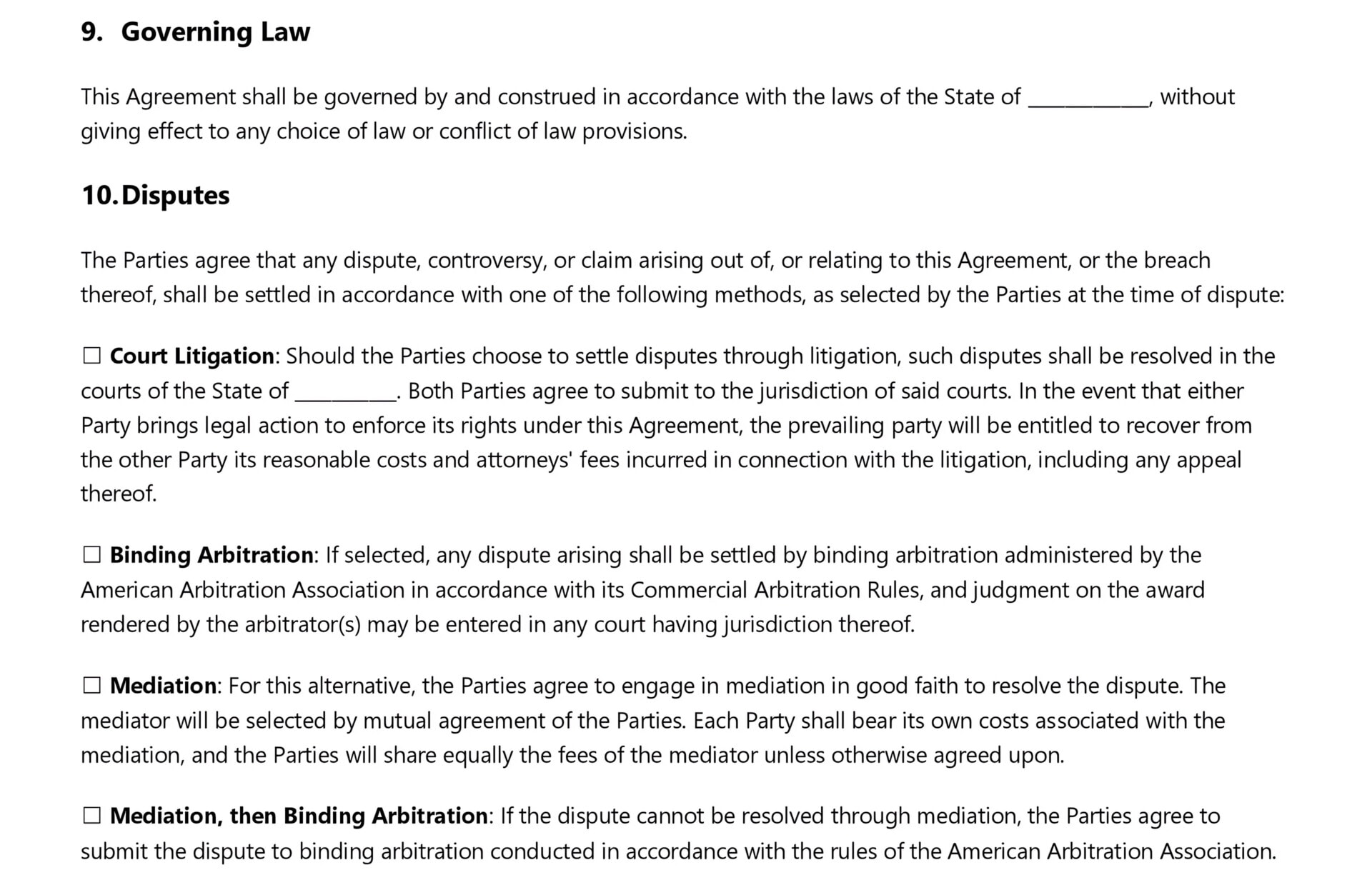

A release of liability and indemnity agreement is a legal document that protects one party from being held responsible for injuries, damages, or losses incurred by another party during a specific activity or event. It releases the service provider or event host, known as the “releasee,” from legal claims made by the participant, or “releasor.” The releasor agrees to cover any losses or legal costs the releasee might face due to claims resulting from the releasor’s actions. This agreement is often used for high-risk activities, such as sporting events and recreational activities like rock climbing or skydiving. By signing, the releasor acknowledges the risks involved and agrees not to hold the releasee liable, except in cases of gross negligence or intentional misconduct.
This Release of Liability and Indemnity Agreement template is a comprehensive legal document that outlines the responsibilities and protections for two parties involved in an activity or event that may carry risks. This template provides a structured framework to formalize the relationship between the Indemnitor, who agrees to assume liability, and the Indemnitee, who receives protection from potential claims. It includes several placeholders that you must complete to customize the agreement for your specific circumstances.

The introduction section establishes the official commencement of the agreement’s terms and the foundational relationship between the parties. It contains placeholders for the date of the agreement and the names and addresses of both parties. The placeholders “________ day of ___________, 20—” are used to enter the date. Enter the full legal name and address of the Indemnitor and Indemnitee in the blank fields. The Recitals section provides context and purpose for the agreement. In this section, use the placeholder Description of the Activity /Event to describe the specific activity or event, including its nature, location, and scope. Another placeholder, Capacity/Relation to the Activity, is used to specify the Indemnitee’s role or relationship to the activity, such as an organizer, sponsor, or participant.

The Indemnification Clause is central to the agreement, defining the extent of the Indemnitor’s obligations. Users must select from the provided options to specify the scope of indemnity. There are options to cover all acts related to the activity, exclude acts by third parties, or limit indemnity to acts by the Indemnitor. Additionally, users must decide whether the indemnity is limited or not limited to personal injury, loss of life, or property damage by checking the relevant boxes.

In the Exceptions section, the agreement clarifies the boundaries of liability by stating that the Indemnitor is not responsible for claims resulting from the Indemnitee’s sole negligence or willful misconduct.

The Notice of Claim section establishes the process for notifying the Indemnitor of any claims related to the activity. The Indemnitee must provide written notice promptly using the specific contact details provided earlier in the agreement. Once notified, the Indemnitor has the right to assume the defense of the claim, selecting legal counsel with the Indemnitee’s reasonable approval.
The Duty to Defend section outlines the Indemnitor’s obligation to cover all defense-related costs, including legal fees and court expenses.

The Mutual Representations section provides legal assurances that both parties have the authority to enter into the agreement. Each party confirms their capacity to enter into the agreement and assures that it does not conflict with any existing contractual obligations or legal requirements.

The agreement also includes provisions for Amendments and Notices to maintain clarity and communication. Any changes to the agreement must be documented in writing and signed by both parties. All communications under the agreement must be delivered in writing via hand, mail, or email. The placeholders Address and City/State/Zip provide accurate contact information for both parties.

For agreements involving multiple Indemnitors, the Joint and Several Liability section states that each Indemnitor is individually and collectively responsible for fulfilling the entire obligation.

The Governing Law and Dispute Resolution sections specify the legal framework and methods for resolving disputes. Use the placeholder State to indicate which state’s laws govern the agreement. Options for dispute resolution include court litigation, where parties specify the jurisdiction with State, binding arbitration, mediation, or mediation followed by arbitration.

The No Waiver clause states that a party’s failure to enforce any provision does not prevent future enforcement.

The Successors and Assigns section indicates that the agreement applies to the parties and their heirs, successors, and assigns, ensuring continuity beyond the original signatories.


The Severability and Assignments section supports the agreement’s integrity. If any part is found invalid, it will be replaced with a valid provision that matches the original intent. The assignments clause restricts the transfer of rights or obligations without the other party’s consent and maintains control over who is involved in the agreement.

The agreement’s execution is facilitated by the Counterparts section, allowing it to be signed in multiple parts, each considered an original.

The Headings provide clarity and organization but do not affect interpretation.

The Entire Agreement section confirms that this document represents the complete understanding between the parties and supersedes any prior agreements. It requires signatures from both the Indemnitor and Indemnitee, with placeholders for Printed Name, Title, and Date.
Exhibit A includes a space to provide a detailed description of the activity or event. It contains prompts to capture essential details such as dates, location, and nature. This section is crucial for making both parties fully informed about the activity’s specifics.
This template can be accessed in several formats, including DOCX, Google Docs, DOTX, and ODT. This makes it easy to customize the agreement to meet your specific needs.
Insurance and release of liability and indemnity agreements are distinct legal tools, each serving a specific purpose in risk management. These agreements specifically address risks associated with particular transactions or activities. The indemnity clause requires the indemnifier to compensate the indemnitee for specified losses, and the release of liability clause involves the participant accepting risks and agreeing not to pursue legal action. In contrast, insurance provides broad coverage for a wide range of potential risks and operates on a risk pooling model. Policyholders pay regular premiums, which allow insurers to cover large, unpredictable losses. Indemnity and release of liability agreements, governed by contract law, offer targeted protection, while insurance is regulated by strict legal frameworks that ensure standardized and comprehensive coverage. This makes insurance ideal for managing unpredictable liabilities across diverse scenarios, whereas indemnity and release agreements focus on specific, clearly defined risks.